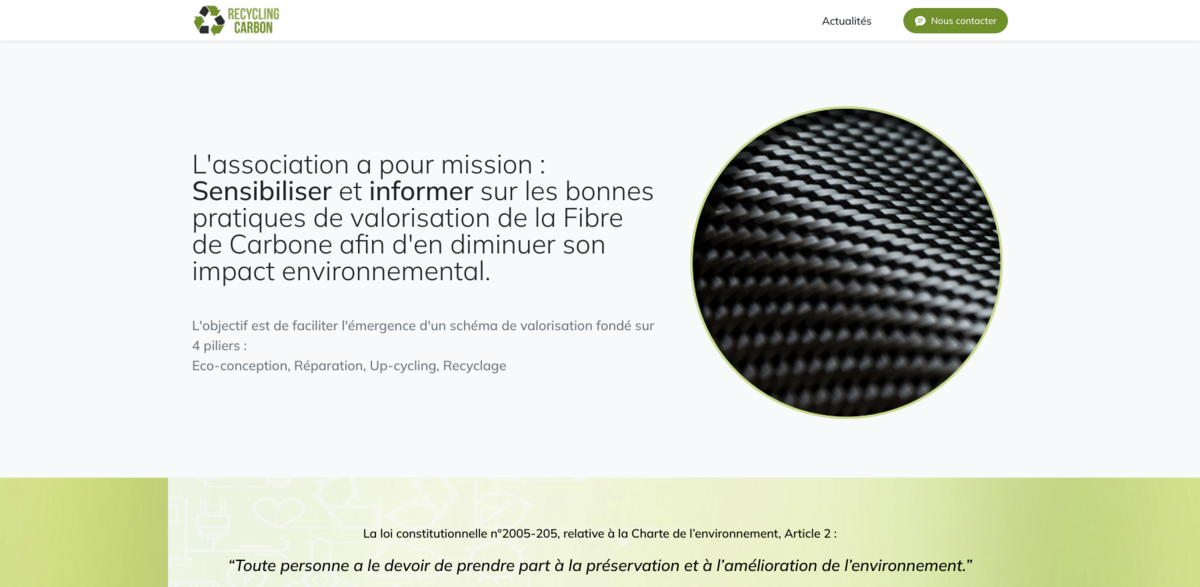What Is Recycling Carbon?
Recycling Carbon is a project created to raise awareness and inform about best practices for recycling carbon fiber to reduce its environmental impact. This initiative focuses on facilitating the emergence of a recycling scheme that is built on four key pillars: Eco-design, Repair, Upcycling, and Recycling. Every second, 2kg of carbon fibers are produced in the world, emphasizing an urgent need to develop effective solutions. The project is driven by the constitutional law n°2005-205 from the Charter of the Environment, which states, “Every person has the duty to participate in the preservation and improvement of the environment.” Recycling Carbon embodies these values, inviting individuals and companies to explore innovative ways to manage carbon fiber waste. It is all about turning challenges into opportunities—yes, even when the world seems to be leaning towards landfill and incineration.
Main Benefit: Transforming Carbon Waste Into Value
The main benefit of this project lies in its holistic approach to carbon fiber waste management. It prioritizes circular economy principles and innovative solutions, providing incredible opportunities across industries from aeronautics and defence to automotive, shipping, and sports. Key figures and facts include:
- Every second, 2kg of carbon fibers are produced globally.
- A focus on integrating eco-design right from the object’s conception.
- Repair strategies that stress “why throw it away if it can be repaired?”
- Upcycling methods that transform waste into resources, creating surprising new uses.
- A reasoned logistics approach to preventing landfill and limiting incineration.
These details underline a dynamic model that not only helps the environment but also supports continuous improvement for companies in the treatment of carbon fiber materials.
Eco-Design: From Conception to Circularity
Eco-design is at the heart of Recycling Carbon’s methodology. At the design stage of an object, planning for its end-of-life and the integration of recycled materials is crucial. It encourages designers to think outside the box, much like considering every twist and turn in a creative conversation… There’s a clear message: build for longevity and eco-responsibility. Adding in the casual vibe, it’s like saying, “Plan ahead, and the future will thank you!” This approach not only contributes to the reduction of carbon waste but also sets the stage for a circular economy wherever carbon fiber is used.
Repair and Upcycling: Breathing New Life Into Old Materials
The concepts of repair and upcycling are central to transforming waste into valuable resources. Instead of discarding carbon fiber that could be repaired, the repair pillar highlights its strong potential. Imagine a world where everyday items aren’t tossed aside but instead given a second chance to shine; that’s the spirit here. Alongside repair, upcycling inspires creative twists by transforming discarded materials into something new and useful. It challenges conventional thinking and supports the idea that waste can be a starting point for innovative solutions. In an industry where carbon fiber is everywhere—even in unexpected places—these pillars prove essential for sustainable progress.
Recycling: A New Horizon for Carbon Fiber Waste
The recycling pillar brings forward effective logistics to reduce carbon fiber waste in landfills. It addresses one of the biggest challenges of recycling these light and complex materials: preserving the properties of the fiber while minimizing deterioration. Recycling Carbon demonstrates that there is an alternative path to conventional waste management methods, such as landfill and incineration. The journey to recycle carbon fiber is not only about processing a material—it’s about reshaping an entire industry with eco-responsible practices. By sharing best practices and continuously monitoring recycling actors and solutions, new synergies are formed among stakeholders in the composites sector. It really is an inspiring move towards a greener approach.
Contribution and Collaboration: A Community Effort
Both individuals and companies are encouraged to come together and contribute to the Recycling Carbon movement. The project offers various ways to get involved, be it through highlighting a unique recycling solution or engaging in collaborative efforts that advance technical support. The contributor status, earned through a donation, opens the door for participants to gain tailored advice from a team of qualified volunteers. This support system is designed to facilitate efficient management of carbon fiber waste. While the contributor status needs to be renewed annually—which ensures a constant flow of renewed commitment—it also builds a network of eco-conscious stakeholders dedicated to shaping a sustainable future.
Project Impact: Advancing Global Sustainability Goals
- SDG 9: Industry, Innovation, and Infrastructure
- SDG 11: Sustainable Cities and Communities
- SDG 12: Responsible Consumption and Production
- SDG 13: Climate Action
Looking Forward: A Greener Tomorrow for Carbon Fiber
Recycling Carbon stands at the forefront of a promising market that aligns industrial progress with a green conscience. Businesses in sectors like aeronautics, defence, automotive, shipping, and even sports can see first-hand how effective solutions adapted to their needs can pave the way towards an economically virtuous and eco-responsible model. The project is driven by an intent to energize the conversation, create synergies among stakeholders, and challenge the conventional means of handling carbon waste. With a focus on circular economy, the momentum built by Recycling Carbon continues to push for innovative, tailored practices. This isn’t just about managing waste—it’s about reimagining a system where every carbon fiber has value, helping preserve the environment one step at a time… and that is exactly the kind of change the modern world needs.





















